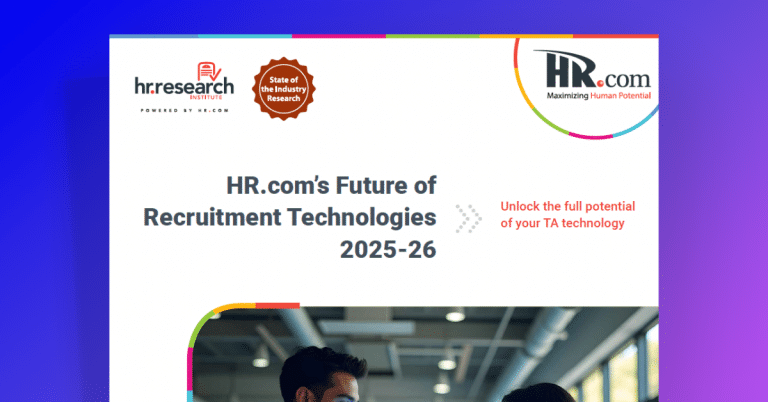
HR.com’s future of recruitment technologies 2025-26
HR.com’s future of recruitment technologies 2025-26
Recruiting has never been more complex or more full of opportunity.
According to HR.com’s Future of Recruitment Technologies 2025–26 research, organizations are investing heavily in talent acquisition tools, yet few are realizing their full potential. Their most recent report uncovers where progress is happening, where gaps remain, and what separates technology leaders from the rest.
Explore the research to learn:
- Why only 43% of organizations rate their talent acqusition stack as “good” or “excellent.”
- How organizations that embrace advanced technologies see stronger outcomes in quality of hire, retention, and time-to-fill.
- Why leading organizations are integrating AI into sourcing, screening, and candidate engagement to drive efficiency and fairness.
- How to modernize your TA tech stack and invest strategically for the next wave of recruiting innovation.
This briefing synthesizes the findings from HR.com’s “Future of Recruitment Technologies 2025-26” survey, which reveals a significant paradox in the talent acquisition (TA) landscape: while most organizations have adopted recruitment tools, their perceived value remains low. Only 43% of HR professionals rate their TA technology stack as “good” or “excellent,” highlighting a persistent gap between investment and impact. This dissatisfaction is rooted in uneven technology adoption, where foundational tools like Applicant Tracking Systems (ATS) are ubiquitous (78%), but more advanced, value-driving technologies such as recruitment analytics (35%) and extensive AI (14%) are significantly underutilized.
A critical divide exists between “Recruitment Technology Leaders” (those who rate their tech stack highly) and “Laggards.” Leaders consistently outperform Laggards across every major metric—from adoption of advanced tools and diverse advertising channels to the effective measurement of outcomes like time-to-fill and quality of hire. Their success demonstrates that strategic integration of AI, mobile capabilities, and analytics is the key differentiator.
Key challenges persist across the industry, including a high rate of regrettable hires—only 23% of organizations would rehire 76-100% of employees hired in the last year—and poor measurement of crucial efficiency metrics like cost-per-hire. Looking forward, organizations are prioritizing candidate experience, analytics, and operational efficiencies. Over half expect AI use in recruitment to increase, signaling a gradual but decisive shift toward more automated, data-driven, and integrated TA strategies.
1. The current state of talent acquisition technology stacks
The report indicates that while TA technology is improving, its adoption is uneven and its value is not fully realized by a majority of organizations. A clear performance gap has emerged between organizations that strategically leverage technology and those that do not.
A paradox of adoption and value
Despite widespread use of recruitment tools, less than half of organizations are satisfied with the results.
- Overall satisfaction: Only 43% of HR professionals rate their TA technology stack as “good” or “excellent” at improving recruitment and hiring capabilities. 40% rate it as “average,” and 16% as “poor” or “below average.”
- Historical trend: This figure represents a slight decrease from 45% in 2024, but an improvement from 39% in 2023, suggesting modest progress that may be plateauing.
- Organizational size: Larger organizations (1,000+ employees) are more likely to rate their tech stack highly (55%) compared to small and midsized organizations (33% for both).
Uneven technology adoption
Adoption is heavily concentrated in foundational systems, with a steep drop-off for more advanced, insight-driven tools.
- Dominant technologies: The most widely adopted tools are Applicant Tracking Systems (ATS) at 78% and employment hiring platforms (e.g., Indeed) at 67%.
- Lagging technologies: Adoption rates for more strategic tools are significantly lower:
- Onboarding automation: 44%
- Employee referral solutions: 39%
- Recruitment analytics: 35%
- Video interviewing: 31%
- Skills assessments: 31%
- Candidate Relationship Management (CRM): 21%
The performance gap: Technology leaders vs. laggards
Organizations defined as “Recruitment Technology (RT) Leaders” (rating their stack as good/excellent) demonstrate significantly higher adoption of advanced tools compared to “RT Laggards” (rating their stack as average or poor).
| Technology type | RT leaders adoption | RT laggards adoption |
| Background/Reference checking | 70% | 49% |
| Employee referral solution | 58% | 26% |
| Recruitment analytics tools | 55% | 20% |
| Dedicated social/Branding tools | 52% | 26% |
| Video interviewing technology | 45% | 24% |
| Assessment tools | 45% | 21% |
2. The cautious adoption and application of artificial intelligence
AI is gaining traction in talent acquisition, but its implementation remains cautious and is largely confined to administrative or content-generation tasks rather than strategic decision-making.
AI adoption trends
The use of AI is growing steadily, though a significant portion of organizations still avoid it entirely.
- Current adoption: 14% of organizations use AI extensively, 49% use it to some extent, and 37% do not use it at all.
- Growth over time: The percentage of organizations not using AI has fallen dramatically, from 73% in 2023 to 37% in 2025. Extensive use has grown from 5% to 14% in the same period.
- Leaders vs. laggards: A stark divide exists, with 27% of RT Leaders using AI to a large extent, compared to only 3% of Laggards.
Current use cases and perceived benefits
AI’s primary role is currently supportive, focused on content creation and efficiency.
- Top AI activities:
- Creating interview questions: 67%
- Writing job descriptions: 65%
- Resume filtering: 44%
- Candidate communications: 43%
- Broader use by leaders: Leaders apply AI more broadly, including in candidate communications (56% vs. 31% of Laggards), automated note-taking (49% vs. 20%), and initial screening (39% vs. 9%).
- Primary benefit: Time savings is the most recognized benefit of AI, cited by 70% of respondents. Other benefits include more automated processes (45%) and more efficient screening (36%).
Key concerns and safeguards
Concerns about bias, depersonalization, and legal risks are significant barriers to wider AI adoption.
- Top concerns:
- Risk of bias in AI systems (58%)
- Depersonalization of the recruitment process (51%)
- Legal risks and noncompliance (50%)
- Important safeguards: To mitigate these risks, organizations prioritize:
- Establishing guidelines for AI-related decision-making (57%)
- Training recruiters on AI (56%)
- Complying with AI-related laws (49%)
- Conducting AI bias audits (41%)
3. Measuring recruitment performance and outcomes
While organizations track some metrics well, they struggle to quantify efficiency and cost, and the data suggests a significant challenge with the quality of hires.
Inconsistent measurement capabilities
The ability to accurately measure recruitment outcomes varies widely by metric.
- Best-tracked metric: Retention of new employees is the most effectively measured outcome, with 48% rating their ability as “above average” or “excellent.”
- Poorly-tracked metrics: Efficiency metrics lag significantly behind:
- Time to fill: 35%
- Cost per hire: 27%
The challenge of regrettable hires
A substantial portion of hiring decisions are viewed as suboptimal in retrospect, indicating gaps in selection or onboarding processes.
- Only 23% of organizations would rehire 76–100% of employees hired in the past 12 months.
- Approximately 43% would rehire half or fewer of their recent hires.
Leaders’ superiority in measurement
RT Leaders are up to three times more likely than Laggards to effectively measure key recruitment metrics, enabling more data-driven decision-making.
| Metric | RT leaders (% “Above average/Excellent”) | RT laggards (% “Above Aaerage/Excellent”) |
| Retention of new employees | 62% | 33% |
| Time to fill | 54% | 18% |
| Hiring manager satisfaction | 52% | 25% |
| Quality of hire | 49% | 26% |
| Candidate experience | 47% | 26% |
| Cost per hire | 41% | 13% |
4. Key channels and mobile engagement strategies
Recruitment efforts rely heavily on traditional channels, while more advanced mobile and programmatic advertising methods remain underutilized, representing a missed opportunity for broader reach and improved candidate experience.
Job advertising channel mix
Organizations favor established, high-volume channels but are slow to adopt more targeted, proactive methods.
- Top channels: Company website (85%), job boards (84%), and social media (82%).
- Underutilized channels: Programmatic advertising (16%), alumni associations (25%), and talent communities (32%) see limited use.
- Leaders’ advantage: RT Leaders utilize a more diverse mix, with significantly higher adoption of programmatic advertising (33% vs. 4% of Laggards) and talent communities (42% vs. 24%).
Mobile recruitment: An underleveraged opportunity
While a majority of organizations have mobile-friendly applications, most have not embraced more advanced mobile engagement tools.
- Mobile optimization: 58% of organizations report having a mobile-optimized or device-agnostic job application process. RT Leaders (75%) are far more likely to have this than Laggards (43%).
- Common mobile uses: Phone interviews (49%), mobile-accessible career sites (44%), and texting candidates (42%).
- Advanced mobile tool gaps: Adoption of more sophisticated mobile tools is low:
- Social recruiting: 25%
- Mobile recruitment apps: 20%
- Text-to-apply: 16%
- Chatbots: 11%
- Leaders vs. laggards: Leaders adopt advanced mobile tools like mobile apps (37% vs. 9%) and text-to-apply (30% vs. 7%) at much higher rates.
5. Future outlook and strategic priorities
Looking ahead, organizations plan to increase investment in TA, with a clear focus on enhancing candidate experience, leveraging analytics for data-driven decisions, and expanding the use of AI.
Planned investments
Most organizations anticipate moderate to strong increases in resources for TA over the next two years, signaling its strategic importance.
- TA methods and practices: 64% plan a moderate or great increase.
- Online sourcing and advertising: 61% plan a moderate or great increase.
- TA technologies and tools: 59% plan a moderate or great increase.
Top technology priorities
When selecting new TA technologies, the primary drivers will be improving the candidate journey and operational effectiveness.
- Top 3 priorities:
- Candidate experience (65%)
- Analytics and tracking (59%)
- Efficiencies and optimizations (58%)
- Other key capabilities include integration with other systems (55%) and identification of best candidates (52%).
Expected trends for the next two years
HR professionals anticipate a continued evolution toward more automated, intelligent, and candidate-centric recruitment.
- 53% expect the use of AI in recruitment will increase.
- 53% expect recruitment technologies will become more useful.
- 40% expect to place greater emphasis on candidate experience.
- 39% expect hiring will involve more data-based decisions.
6. Strategic recommendations
The report concludes with several key takeaways and recommendations for organizations seeking to improve their recruitment outcomes.
- Audit and optimize the tech stack: Conduct a full audit of the ATS and related tools to identify underutilized features, integration gaps, and redundant platforms.
- Expand adoption of advanced tools: Pilot and adopt tools like recruitment analytics, video interviewing, and skills assessments to strengthen decision-making and improve quality of hire.
- Integrate AI strategically: Move beyond content creation to integrate AI into sourcing, screening, and candidate engagement to improve efficiency and consistency.
- Improve recruitment measurement: Implement standardized dashboards to track key metrics like time-to-fill, cost-per-hire, and quality of hire alongside retention.
- Maximize mobile engagement: Ensure all applications are fully mobile-optimized and pilot advanced tools like chatbots and mobile apps to enhance the candidate journey.
- Address AI risks proactively: Develop clear AI policies, conduct bias audits, and provide recruiter training to build trust and ensure responsible, compliant implementation.
- Tailor strategies for senior roles: Develop proactive sourcing strategies and internal talent pipelines for senior-level and hard-to-fill positions, which take the longest to fill.
- Prioritize candidate experience and efficiency: Align technology investments with the core goals of improving the candidate journey and achieving greater operational effectiveness.
You might also like...
Get the latest talent news in your inbox every month
By submitting this form, I consent to Eightfold processing my personal data in accordance with its Privacy Notice and agree to receive marketing emails from Eightfold about its products and events. I acknowledge that I can unsubscribe or update my preferences at any time.
